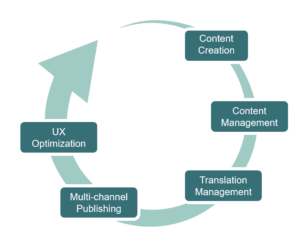Localizing your business concerns all areas of your operations when you are looking to grow in several regions. First, you must consider local legislation, tax regulations, and industry-specific product regulations. You also need to adapt your global business model to any of your local markets, understand your local competition and your local customers. In this article, however, we focus on systematically localizing your content and product into the language of your various target markets.
WHY translating your global content may be mandatory for local growth
Growing a B2B tech company in different regions is exciting, localizing your content and product not so much. Translating and making your content accessible to your local customers will quickly evolve into a time-consuming, massive task.
But – depending on your industry- there is no way around it if you are serious about growing your market share in a foreign market.
Companies that plan to make serious money in Europe will not be able to avoid investing in the localization of their content and product since it is a key to having successful outcomes. Europeans speak 21 different main languages (-not counting all the different regional languages and dialects-). The reality: the famous “single market” is many different markets with a single set of rules. Even if your focus is only on some countries, you will have to consider what languages your target markets speak.
Educational levels in Europe are generally high. Chances are that your customers may understand (a little bit) of English. Yet, most of us here in Europe like to discuss our business problems in our mother tongue. You will sell more if you help your customers solve their problems in their own language, – not in yours.
Consequently, sales become far more manageable if you become part of the local European communities. You will lose market share if you are not doing what local competitors and global leaders do naturally: offer services in the language of their customers.
This is why a global information management strategy should be one of the key components of your go-to-market planning from the onset.
WHAT will you need to translate?
You want to make it easier for your customers to engage with your product, content, and company. But which parts exactly do you need to translate into your customer’s preferred language? And what key pieces of content need to be prioritized?
Just look at your current business model and see how your customers decide on your product in your home market. Chances are high that customers will be checking you out online before deciding on your product or subscribing to your services. Expect that they will also be searching the internet to see what other options they have to compare against what you are offering.
A future customer may begin researching their options by reviewing:
- Product features and comparable alternatives from your competitors
- Online reviews
- Local social media channels
- Google Ads or Social Media ads
They will likely go to your homepage and look at your marketing materials once they are seriously considering your offer. They may even want to speak to your local sales representative to discuss your offerings in more depth.
Once they have decided to test or buy your product, they will look for any (technical) support material and relevant information that can be helpful to familiarize themselves. Like in real life, it is important that you nurture the ongoing relationship that you have established to avoid any unnecessary churn or friction. This attention and care can mean a huge difference and ultimately decide about your success. Happy customers are loyal customers. First impressions and onboarding set the tone for the relationship and loyalty with your brand.
You should translate all pieces of content that are touchpoints and decisive for the customer journey.
A clever content localisation strategy will not only help you to grow your revenue within these regions, it will also help you to save costs when onboarding customers and then throughout the customer lifecycle.
HOW do you implement a systemized translation and version control while staying on brand no matter the language?
Developing the right global information strategy, building systems and processes will ultimately save you time and money as you will avoid burning unnecessary resources and duplicated efforts.

The Global Information Management for Dummies handbook identifies five stages that you need to consider while localising your content. Companies will have to consider each of the stage
s that we try to visualize in this graph.
Here are the first few steps to consider when developing your global localisation strategy:
- Put yourself in your customers’ shoes and see what they need to feel like when dealing with a local company (see above).
Look at all of your customers’ touch points during their journey. If you support your sales team with suitable marketing collateral, they will bring you more customers and therefore more €£$.
If you offer great support material, you may not have to rely so much on expensive local customer support.
- A global Style policy for a seamless translation experience.
Your messaging needs to stay consistent regardless of the language. Your translation agencies should also always apply the same legal, technical, or marketing terms.
If you work with various content marketers, you may also consider implementing a global Style guide that will help your writers to stay on message. A style guide like a user manual for writers will help you stay consistent with your content
- Test your local messaging
If you have read any of our past blogs, you already know that unless you are already established, we recommend briefly testing new measures before doubling down and going “all in”. Soon after you have some valuable data about what works best, it’s time to determine the most effective way to implement your long-term plan for establishing your sales and marketing team and content.
Your customers in Germany may engage with you on different local channels then your French, UK or American customers. Hence, localize your channels too and engage in local and online communities, and get featured in the regional media and develop your local brand!
In any case, we strongly advise working with local representatives who can help you spread your message within the local markets.
See recommended reading: Considering New Regions in the EU? Go where You Can Be the Local Beacon
- Streamlining information growth while remaining compliant
On the one hand, you can save costs and stay on brand by reusing standardized content. On the other hand, it will be easier to stay compliant. Europe loves regulations. You will need to consider the local legal requirements while getting your message across to your customers.
Consider structured content that divides more significant content into smaller reusable pieces that you can then use and reuse for your different channels. Avoid complexity in managing information growth in multiple languages from the onset!
- Introduce a Translation Management System (TMS) to reduce Costs and retain quality
Inconsistency in your content can lead to different translations with different terms that may be off-brand and communicate your value proposition differently. The right translation agencies will aim to avoid this, but without clear guidance, every translator will interpret your material differently. Introducing a translation system that provides foundational guidance for terms used in original documents will reduce translation costs and duplicated efforts.
Centralizing and automating as many pieces as possible of this process will increase your efficiency and help to retain control. Translation memory software can help to leverage centralized approved terminology and translation memory. Professional translation agencies are using these systems and do not charge (much) for repetitive terms, sentences, or paragraphs that their system recognises from previous translation jobs.
There is no one size fits all approach to managing your global information strategy. Your planning needs to align with your objectives, target industry and local market. LaKlas can help you to uncover the most efficient and effective ways to communicate with your customers while building a solid foundation for content and translation management systems.
Contact us to discuss your localization and expansion plans. Even if we do not end up working with each other, you will leave a meeting with new actionable ideas for your global information management planning.
Sources:
- Top 10 Information Management Challenges And Solutions (theecmconsultant.com)
- Global Information Management for Dummies (with complements of SDL)


